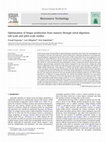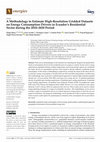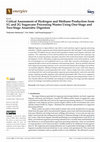Papers by Prasad Kaparaju
Bioresource Technology, 2021
Biomethane production from pretreated cane trash was systematically evaluated. • Multiple linear ... more Biomethane production from pretreated cane trash was systematically evaluated. • Multiple linear regression analysis identified key parameters for biomethane yield. • Biomethane production was best simulated with the Chen & Hashimoto model. • KOH and liquid hot water pretreatments led to predicted highest biomethane yields. • KOH pretreatment led to the highest experimental biomethane yield.
Elsevier eBooks, 2013
Abstract: Biogas is produced during the anaerobic degradation of organic material. The produced b... more Abstract: Biogas is produced during the anaerobic degradation of organic material. The produced biogas can be used for heat, electricity or cogeneration of heat and electricity in a combined heat and power plant (CHP). This chapter first discusses the key issues related to combustion of biogas/biomethane in different stationary equipments. It then describes the utilisation of biogas for the generation of electric power and heat in different stationary applications such as boilers, gas engines (CHP), micro turbines and fuel cells.

Microporous and Mesoporous Materials, Mar 1, 2021
Although zeolite N ( . ) is used commercially for the removal and recovery of ammoniacal nitrogen... more Although zeolite N ( . ) is used commercially for the removal and recovery of ammoniacal nitrogen from wastewater, it has received limited attention in academic literature. The hypothesis was that if an improved understanding of zeolite N synthesis and resultant physical parameters and performance can be acquired, then the application of this material may be accelerated. This study successfully addressed existing research challenges including: maximizing the cation exchange capacity (CEC); selection of preferred synthesis conditions; control of the size, shape, and dispersion of zeolite N crystals; and improvement of ion exchange properties. Zeolite N was hydrothermally synthesised from kaolin clay added to solutions of potassium hydroxide and potassium chloride in a "one pot" process. CEC values increased to 563 meq/100 g (c.f. 528 meq/100 g in previous literature). Reaction between 120 and 140 o C for 2 to 4 h under static conditions was preferred as higher temperatures (180 o C) produced kalsilite. The KOH molarity (1.2 to 4.3 M) controlled the average zeolite crystal size, dispersion, and crystal shape; with highest molarity values optimal. Whereas, added KCl acted as a template which promoted zeolite N formation. Removal of KCl resulted in creation of zeolite F ( ( ) . ) which also belonged to the EDI structural type. Ammonium ion exchange from aqueous solution was improved when diffusion restrictions were eased; as evidenced by using smaller zeolite crystals which were highly dispersed and not agglomerated. Not only was a greater cation capacity recorded but also the time to reach equilibrium was increased.

Resources Conservation and Recycling, 2005
The possible use of potato tuber and its industrial by-products (potato stillage and potato peels... more The possible use of potato tuber and its industrial by-products (potato stillage and potato peels) on farm-scale co-digestion with pig manure was evaluated in a laboratory study. The methane yields (m 3 kg -1 volatile solids (VS) added waste ) achieved on semi-continuous co-digestion at loading rate of 2 kg VS m -3 day -1 in continuously stirred tank reactors at 35 • C were 0.13-0.15 at 100:0 (VS% pig manure to VS% potato co-substrate), 0.21-0.24 at 85:15 and 0.30-0.33 at 80:20 feed ratio. Increasing the loading rate from 2 to 3 kg VS m -3 day -1 at a feed VS ratio of 80:20 (pig manure to potato waste) produced methane yields of 0.28-0.30 m 3 kg -1 VS added waste . Post-digestion (60 days) of the digested materials in batches produced 0.12-0.15 m 3 kg -1 VS added waste of methane at 35 • C. The results suggest that successful digester operation can be achieved with feed containing potato material up to 15-20% of the feed VS and that under similar feed VS, loading rate, retention time and feed VS ratio, the methane yields and process performance for potato tuber would be similar to that of its industrial residues. Thus, co-digestion of potatoes and/or its industrial by-products with manures on a farmscale level would generate renewable energy and provide a means of waste treatment for industry.

Bioresource Technology, 2009
In the present study, the possibility of optimizing biogas production from manure by serial diges... more In the present study, the possibility of optimizing biogas production from manure by serial digestion was investigated. In the lab-scale experiments, process performance and biogas production of serial digestion, two methanogenic continuously stirred tank reactors (CSTR) connected in series, was compared to a conventional one-step CSTR process. The one-step process was operated at 55 °C with 15 d HRT and 5 l working volume (control). For serial digestion, the total working volume of 5 l was distributed as 70/30%, 50/ 50%, 30/70% or 13/87% between the two methanogenic reactors, respectively. Results showed that serial digestion improved biogas production from manure compared to one-step process. Among the tested reactor configurations, best results were obtained when serial reactors were operated with 70/30% and 50/50% volume distribution. Serial digestion at 70/30% and 50/50% volume distribution produced 13-17.8% more biogas and methane and, contained low VFA and residual methane potential loss in the effluent compared to the one-step CSTR process. At 30/70% volume distribution, an increase in biogas production was also noticed but the process was very unstable with low methane production. At 13/87% volume distribution, no difference in biogas production was noticed and methane production was much lower than the one-step CSTR process. Pilot-scale experiments also showed that serial digestion with 77/23% volume distribution could improve biogas yields by 1.9-6.1% compared to one-step process. The study thus suggests that the biogas production from manure can be optimized through serial digestion with an optimal volume distribution of 70/30% or 50/50% as the operational fluctuations are typically high during full scale application. However, process temperature between the two methanogenic reactors should be as close as possible in order to derive the benefits of serial coupling.

Environmental Technology, Aug 1, 2006
Three operational strategies to reduce inhibition due to ammonia during thermophilic anaerobic di... more Three operational strategies to reduce inhibition due to ammonia during thermophilic anaerobic digestion of source-sorted organic fraction of municipal solid waste (SS-OFMSW) rich in proteins were investigated. Feed was prepared by diluting SS-OFMSW (ratio of 1:4) with tap water or reactor process water with or without stripping ammonia. Three continuously stirred tank reactors were operated at 55 degrees C with 11.4 gVS d(-1) loading rate and 15 d retention time. Total ammonia nitrogen (TAN) level in the reactor fed with recirculated water alone was spiked to 3.5 and 5.5 g-N l(-1) through ammonium bicarbonate additions. Dilution of SS-OFMSW with fresh water showed a stable performance with volatile fatty acids of < 1g l(-1) and methane yield of 0.40 m3 kg(-1) volatile solids (VS). Use of recirculated process water after stripping ammonia showed even better performance with a methane yield of 0.43 m3 kg(-1) VS. Recirculation of process water alone on the other hand, resulted in process inhibition at both TAN levels of 3.5 and 5.5 g-N l(-1). However, after a short period, the process recovered and adapted to the tested TAN levels. Thus, use of recirculated process water after stripping ammonia would not only evade potential inhibition due to ammonia but could avoid the use of fresh water for dilution of high solids protein-rich SS-OFMSW.

Renewable Energy, 2011
Anaerobic digestion (AD) is an important technology to produce biogas from dairy manure. Although... more Anaerobic digestion (AD) is an important technology to produce biogas from dairy manure. Although the AD of dairy manure results in the harnessing of the energy contained in manure, most of the nutrients (phosphorous and nitrogen) remain in the liquid effluent, representing an important source of pollution. Additionally, the biogas produced contains H S and CO , limiting its practical use as fuel. In this paper, we report the production and use of a carbonaceous adsorbent from AD fibers for the removal of hydrogen sulfide (H S) from biogas and phosphate (PO ) from aqueous liquid effluents. The adsorbents studied were produced via slow pyrolysis between 350 and 800 °C followed by CO activation. The elemental and proximate analyses, surface area and pore size distribution of each of the adsorbents studied are reported. Their adsorption capacities were assessed using H S breakthrough and PO batch equilibrium tests. The sorption capacity varied between 21.9 and 51.2 mg g for H S and between 4.9 mg g and 37.4 mg g for PO . Commercially available activated carbon studied adsorbed 23.1 mg g H S and 15.7 mg g PO . The results show that the retention of H S and PO compounds were governed by the ash content, Engineering uncontrolled terms Adsorption capacities Adsorption mechanism Anaerobically digested fibers Batch equilibrium Bio chars Liquid effluents Proximate analysis Sorption capacities Engineering main heading: Anaerobic digestion GEOBASE Subject Index: activated carbon adsorption anaerobic digestion aqueous solution biochar effluent hydrogen sulfide manure phosphate pore space pyrolysis size distribution Funding details

Energies
Biogas from lignocellulosic feedstock is a promising energy source for decentralized renewable el... more Biogas from lignocellulosic feedstock is a promising energy source for decentralized renewable electricity, heat, and/or vehicle fuel generation. However, the selection of a suitable energy crop should be based on several factors such as biomass yields and characteristics or biogas yields and economic returns if used in biorefineries. Furthermore, the food-to-fuel conflict for the use of a specific energy crop must be mitigated through smart cropping techniques. In this study, the potential use of sweet sorghum as an energy crop grown during the fallow periods of sugarcane cultivation was evaluated. Nine sweet sorghum cultivars were grown on sandy loam soil during September 2020 in North Queensland, Australia. The overall results showed that the crop maturity had a profound influence on chemical composition and biomass yields. Further, the total insoluble and soluble sugar yields varied among the tested cultivars and were dependent on plant height and chemical composition. The bioma...
Journal of Environmental Chemical Engineering

Environmental Technology, 2022
AbstractSugarcane is the most traded crop in the world, with Brazil being the world's largest... more AbstractSugarcane is the most traded crop in the world, with Brazil being the world's largest producer. Sugarcane processing generates up to 28% of sugarcane bagasse (SB) from the entire plant, with only 50% of it used for energy generation. SB is a lignocellulosic biomass that can be converted into biogas. However, the optimization of pretreatment process parameters is essential for its successful scaling up. This study evaluated the effect of mild alkaline pretreatment of SB using NaOH and KOH at concentrations of 1-10% and exposure time of 1-12 hours) on the biochemical methane potential (BMP) under mesophilic temperature. The central composite rotatable design (CCRD) was applied as statistical tool to generate optimal operating pretreatment conditions. The tests were performed in triplicates totalizing 84 batch bottles. The BMP of the untreated SB varied between 297-306 LN CH4 kg VS-1 while the BMP of the pretreated samples with NaOH and KOH were 19% and 20% higher. The optimized conditions were NaOH at 7.7% and KOH at 8.3% KOH for 12 hours. However, the range indicated by the statistical design with CCRD revealed that there was no statistical difference in terms of methane yield when concentrations between 4-10% NaOH and 6-10% KOH during 12 hours were applied, when compared to the specific optimized points. The optimization of the pretreatment parameters demonstrated to be a key-factor to improve the anaerobic digestion of lignocellulosic substrates, leading to a less chemically dependent and more sustainable approach, while allowing a more profitable process.

Mires and Peat, 2020
1) In Finland, in recent years, the combustion of dry reed canary grass (RCG, Phalaris arundinace... more 1) In Finland, in recent years, the combustion of dry reed canary grass (RCG, Phalaris arundinacea) grown intensively on cutover peatlands, has decreased markedly. We therefore made experiments in two areas to assess the alternative of using freshly harvested RCG grown for biogas production on cutover peatland. We measured both biogas production and combustion energy release. (2) The experiments show that the RCG biomass yields in total solids (TS) in both areas, with two cuts a year, were surprisingly small (yields of 2.7 and 4.2 Mg ha -1 [1 Mg ha -1 = 100 g m -2 ]); having biogas and combustion potentials, on the two areas, of 277-348 dm 3 kg -1 VS (volatile solids) and 14.8-16.3 MJ kg -1 TS, and 11.8-21.9 MWh ha -1 in combustion. (3) Fresh RCG may produce larger biomass yields if cut several times a year, together with lower lignin proportion, and better suitability for biogas production compared with spring harvested dry RCG. (4) For cutover peatlands there are several after-use possibilities, however, with different benefits and challenges. For example, peat soil emissions may be affected during the after-use period, and this should be considered when planning the use of cutover peatlands.

Water Science and Technology, 2002
The possible co-digestion of energy crops and industrial confectionery by-products with cow manur... more The possible co-digestion of energy crops and industrial confectionery by-products with cow manure was evaluated firstly, through long-term batch experiments and secondly, in a farm-scale digester. In batch assays, digestion with mesophilically digested cow manure as inoculum resulted in specific methane yields (m3 kg−1 VSadded waste) of 0.35 for grass hay (particle size <1.0 cm); 0.26 for oats (0.5 cm) and 0.21 for clover (2.0 cm) harvested at vegetative stage and 0.14 (2.0 cm) for clover harvested at flowering stage. Specific methane yields (m3 kg−1 VSadded waste) for confectionery by-products were 0.37 for chocolate, 0.39 for black candy and 0.32 for confectionery raw material. Out the three particle sizes (2.0, 1.0 and 0.5 cm) tested, particle size of 1.0 cm was found ideal for digestion of grass hay and clover while, particle size reduction did not influence methane production from oats. Stage of the crop influenced the methane yields, with clover harvested at vegetative sta...
Energy Conversion and Management, Jun 1, 2022

Energies
There are no methodologies in the literature for estimating the temporal and spatial distribution... more There are no methodologies in the literature for estimating the temporal and spatial distribution of consumption drivers for the residential sector of a region or country. Factors such as energy requirement, population density, outdoor temperature, and socioeconomic aspects are considered the major drivers of consumption and have been found to directly influence residential energy consumption. In this study, a methodology is proposed to evaluate the impact of the above drivers in domestic energy consumption in Ecuador between 2010 and 2020 using publicly available data. This methodology aims to provide a spatiotemporal approach to estimate high-resolution gridded datasets for a 10-year period, 2010–2020, assessing seven energy drivers: (1) gridded population density, (2) gridded space heating requirements, (3) gridded space cooling requirements, (4) gridded water heating requirements, (5) gridded Gross Domestic Product (GDP), (6) gridded per capita GDP, and (7) the Human Development...

Energies
Sugarcane is a lignocellulosic crop which is used to produce sugar in sugarcane processing indust... more Sugarcane is a lignocellulosic crop which is used to produce sugar in sugarcane processing industries. Globally, sugarcane processing industries generate solid and liquid wastes amounting to more than 279 million tons per annum and by-products; namely, trash, bagasse, mill mud, and molasses. The valorisation of waste and by-products has recently increased and is playing a significant role in achieving policies and goals associated with circular bioeconomy and sustainable development. For the valorisation of sugarcane processing industry waste and by-products, a number of technologies are well established and in use, while other innovative technologies are still ongoing through research and development with promising futures. These by-products obtained from sugarcane processing industries can be converted into biofuels like hydrogen and methane via anaerobic digestion. Molasses belongs to the first-generation (1G) waste, while trash, bagasse, and mill mud belong to second-generation ...

Energies
Microalgae, a renewable bio-resource, are considered a potential value-added commodity and a tool... more Microalgae, a renewable bio-resource, are considered a potential value-added commodity and a tool to combat climate change. Microalgal research has received worldwide attention recently. Different perspectives have been explored, but cultivation in outdoor photobioreactors (PBRs) is still a less explored field. This review summarizes the studies conducted on the microalgae cultivated in outdoor PBRs only. The locations, algal strains, PBRs, and cultivation media used in these studies were identified and tabulated. Different aspects of outdoor algal cultivation in PBRs, such as temperature control, light intensity control, photosynthetic efficiency (PE), the outdoor adaptation of strains, PBR designs, and algal growth and biochemical composition variation from the weather, were studied and reviewed. A brief review of downstream processes and environmental and economic impacts was also conducted. This review summarizes what has been carried out in this field so far and will help resea...

Energies
The effect of temporal variation in chemical composition on methane yields of rendering plant was... more The effect of temporal variation in chemical composition on methane yields of rendering plant wastewater was studied in batch experiments at 37 °C. In total, 14 grab samples were collected from Monday through Friday (Day 1 to 5) from a rendering plant located in Queensland, Australia. Each day, three samples were collected: early morning (S1), midday (S2) and afternoon (S3). Chemical analyses showed that a significant different in total solids (TS), volatile solids (VS), and chemical oxygen demand (COD) was noticed among the samples. TS content ranged from 0.13% to 1.82% w/w, while VS content was between 0.11% and 1.44% w/w. Among the samples, S2 of Day 3 had the highest COD concentration (10.5 g/L) whilst S1 of Day 1 had the lowest COD (3.75 g/L) and total volatile fatty acid (VFA) concentration (149.1 mg/L). In all samples, acetic acid was the dominant VFA and accounted for more than 65–90% of total VFAs. Biochemical methane potential studies showed that the highest methane yield ...











Uploads
Papers by Prasad Kaparaju